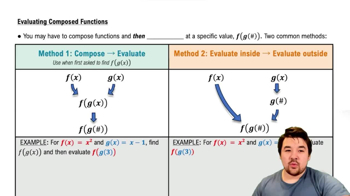Find the gradient vector field of the function . Which of the following is the correct gradient vector field ?
Table of contents
- 0. Functions7h 54m
- Introduction to Functions16m
- Piecewise Functions10m
- Properties of Functions9m
- Common Functions1h 8m
- Transformations5m
- Combining Functions27m
- Exponent rules32m
- Exponential Functions28m
- Logarithmic Functions24m
- Properties of Logarithms36m
- Exponential & Logarithmic Equations35m
- Introduction to Trigonometric Functions38m
- Graphs of Trigonometric Functions44m
- Trigonometric Identities47m
- Inverse Trigonometric Functions48m
- 1. Limits and Continuity2h 2m
- 2. Intro to Derivatives1h 33m
- 3. Techniques of Differentiation3h 18m
- 4. Applications of Derivatives2h 38m
- 5. Graphical Applications of Derivatives6h 2m
- 6. Derivatives of Inverse, Exponential, & Logarithmic Functions2h 37m
- 7. Antiderivatives & Indefinite Integrals1h 26m
- 8. Definite Integrals4h 44m
- 9. Graphical Applications of Integrals2h 27m
- 10. Physics Applications of Integrals 3h 16m
- 11. Integrals of Inverse, Exponential, & Logarithmic Functions2h 34m
- 12. Techniques of Integration7h 41m
- 13. Intro to Differential Equations2h 55m
- 14. Sequences & Series5h 36m
- 15. Power Series2h 19m
- 16. Parametric Equations & Polar Coordinates7h 58m
2. Intro to Derivatives
Derivatives as Functions
Problem 3.7.25b
Textbook Question
Derivatives using tables Let h(x)=f(g(x)) and p(x)=g(f(x)). Use the table to compute the following derivatives.
<IMAGE>
b.
 Verified step by step guidance
Verified step by step guidance1
Identify that h(x) = f(g(x)) is a composition of functions, which requires the use of the chain rule to find its derivative.
Recall the chain rule: if h(x) = f(g(x)), then h'(x) = f'(g(x)) * g'(x).
To find h'(2), substitute x = 2 into the derivative expression: h'(2) = f'(g(2)) * g'(2).
Use the table to find the values of g(2) and g'(2). Substitute these values into the expression.
Next, use the table to find f'(g(2)) by first finding g(2) and then using this result to find f' at that point. Substitute this value into the expression to complete the calculation of h'(2).
 Verified video answer for a similar problem:
Verified video answer for a similar problem:This video solution was recommended by our tutors as helpful for the problem above
Video duration:
2mPlay a video:
Was this helpful?
Key Concepts
Here are the essential concepts you must grasp in order to answer the question correctly.
Chain Rule
The Chain Rule is a fundamental theorem in calculus used to differentiate composite functions. It states that if a function h(x) is composed of two functions, f(g(x)), the derivative h'(x) can be found by multiplying the derivative of the outer function f with the derivative of the inner function g. Mathematically, this is expressed as h'(x) = f'(g(x)) * g'(x). Understanding this rule is essential for solving problems involving derivatives of composite functions.
Recommended video:

Intro to the Chain Rule
Derivative Notation
Derivative notation, such as h'(x) or f'(x), represents the rate of change of a function with respect to its variable. It indicates how the function's output changes as its input changes. In the context of the question, h'(2) specifically refers to the derivative of the function h evaluated at x = 2. Familiarity with this notation is crucial for interpreting and calculating derivatives correctly.
Recommended video:

Sigma Notation
Function Evaluation
Function evaluation involves substituting a specific value into a function to determine its output. In the context of derivatives, evaluating functions at certain points, such as h(2) or g(f(2)), is necessary to compute the derivative using the Chain Rule. This concept is vital for applying the derivatives obtained from the Chain Rule to find specific values, which is often required in calculus problems.
Recommended video:

Evaluating Composed Functions
Related Videos
Related Practice
Multiple Choice
27
views


